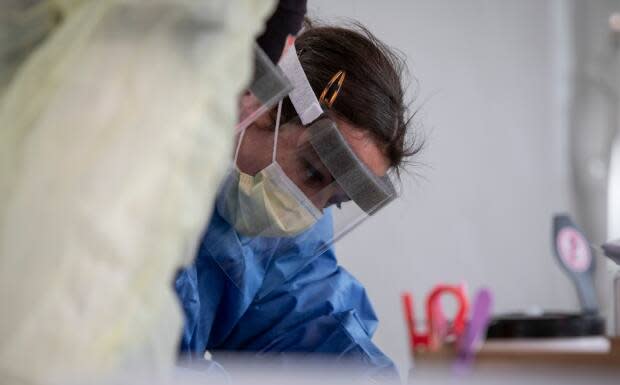PPE must guard against airborne transmission of COVID-19, nurses' union demands

The Ontario Nurses' Association (ONA) is demanding better personal protective equipment (PPE) to protect its members from the aerosol and asymptomatic spread of COVID-19.
In an application for judicial review filed in February, the ONA said the province hasn't done enough to protect health-care workers from COVID-19, singling out a directive from Ontario's chief medical officer of health as inadequate.
When they do ask for it, in many cases it's a battle. - Vicki McKenna, Ontario Nurses' Association
At the time of the application, the ONA said nearly 19,000 health-care workers had been infected in the province.
"What we are asking for is the chief medical officer now to step up," said ONA president Vicki McKenna.
Specifically, the union wants the province to explicitly acknowledge that the virus can be transmitted through the air, that asymptomatic transmission occurs and that nurses need the highest level of precaution available.

'Restricted access' to adequate PPE
Currently, the directive to hospitals and long-term care homes only recognizes that COVID-19 is spread through droplets, McKenna said. Nothing in the directive specifically mentions protection from airborne transmission, she said.
"[Not] putting those statements in the directive [is] causing major issues in the workplace," McKenna said. "[We] still, after all this time, we have nurses and health professionals out there that have restricted access to the proper PPE for airborne transmission. And when they do ask for it, in many cases it's a battle."
McKenna said the PPE available to nurses should include N95 masks, if not reusable elastomeric or powered air purifying respirators.

Lessons from SARS
The ONA argues the province is ignoring the precautionary principle, a key lesson from the SARS crisis that dictates maximum caution during an outbreak, even if our knowledge about how the disease spreads is incomplete.
"From the earliest days of the pandemic, our public health leaders, based on really limited information, dismissed the possibility that COVID-19 could be spread through the air," said Mario Possamai, former senior adviser to the 2007 SARS Commission, who has also written a report on COVID-19 for the ONA.
"We could have really focused on ... better protection for health-care workers, better ventilation, all the things that are involved in addressing an airborne risk. We missed that opportunity … and it's disappointing."
Federal health officials only recognized the airborne spread of COVID-19 in November, and quietly updated their guidelines.
Ontario's Ministry of Health said it cannot comment on the case as it is before the courts. The first hearing for the judicial review is scheduled for May 12.

